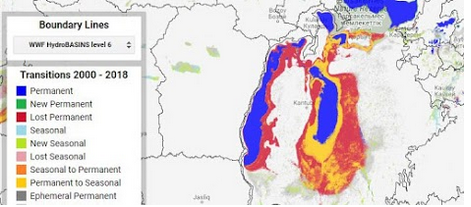
A groundbreaking web-based platform to monitor global freshwater ecosystems was endorsed at last weekend's United Nations Science-Policy-Business forum in Nairobi, ahead of the Fourth UN Environment Assembly, the world’s highest-level decision-making body on the environment.
The Water-Related Ecosystems platform was jointly developed by the European Commission’s Joint Research Centre (JRC), Google and UN Environment. This new platform is based on the JRC’s Global Surface Water Explorer (GSWE) dataset, which was officially endorsed as the official indicator for monitoring progress towards target 6.6 (Ecosystems) of the Sustainable Development Goals (SDGs), of which UN Environment is the custodian agency. This indicator - SDG indicator 6.6.1 - seeks to track changes in the extent of water-related ecosystems over time, contribute to halting the degradation and destruction of water-related ecosystems, and to assist the recovery of those already degraded.
The new platform brings together the JRC's expertise in satellite data mining and environmental monitoring, Google's cloud computing and artificial intelligence and UN Environment’s scientific knowledge, to show how water ecosystems are changing over time. The data will be used to inform a global audience on the status and trends of fresh water bodies, and monitor progress towards SDG 6.6.1.

The platform builds on the JRC's Global Surface Water Explorer (GSWE) – a hugely powerful tool developed by the JRC and Google Earth Engine that maps the location and temporal distribution of water surfaces at the global scale over > three decades and provides statistics on the extent and change of water surfaces.
Through the GSWE, the JRC is committed to providing continuous monitoring of global surface water dynamics for the next 10 years at least.

The monitoring methodology for indicator 6.6.1, on which the new indicator platform is based, was classified by the Inter Agency Expert Group on SDGs as Tier I, the highest classification an indicator methodology can reach. This is testament to the applicability of Earth observation data within the United Nations 2030 Agenda for Sustainable Development.
By providing satellite images accompanied by downloadable statistical data and trend analysis, the new platform can help the 193 UN Member States understand changes occurring in the spatial extent of open water bodies; identify new or lost water bodies; and identify where changes are occurring in seasonal water bodies.
Further information
- SDG 6.6.1: Water-related ecosystems
- Global Surface Water Explorer
- Mapping long-term global surface water occurrence
- Sustainable Development Goal 6.6
- Plugging the data gap: Google, European Commission's Joint Research Centre and UN Environment unveil freshwater monitoring app
Related Content
SDG 6.6.1: Water-related ecosystems
Mapping long-term global surface water occurrence
Details
- Publication date
- 15 March 2019
